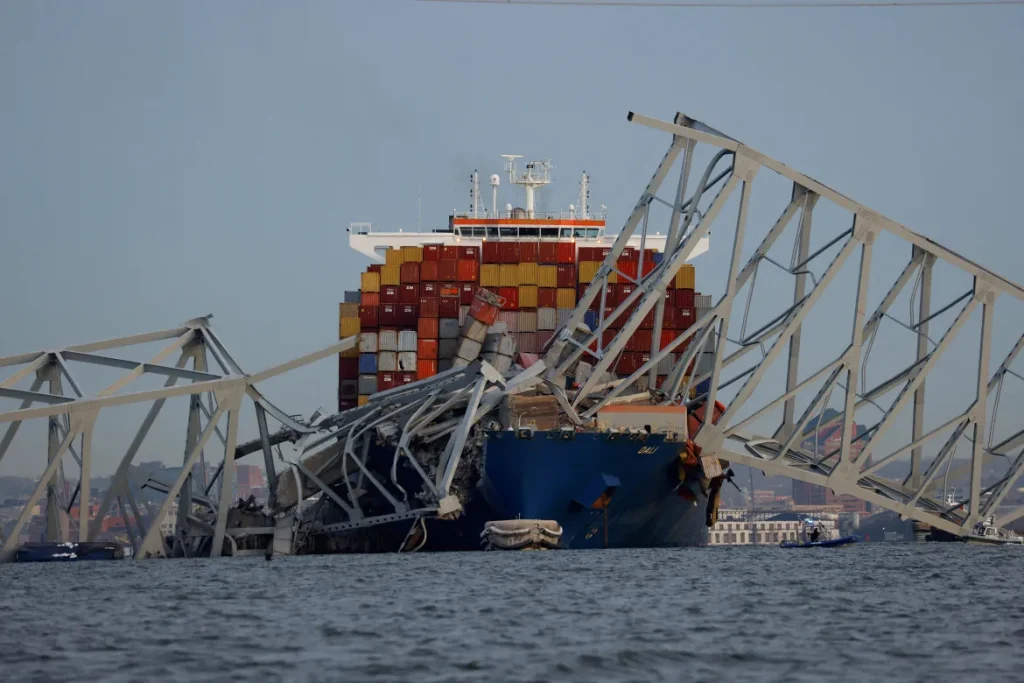BALTIMORE (AP) — The container ship that caused the collapse of Baltimore’s Francis Scott Key Bridge, resulting in six fatalities, was successfully refloated at high tide on Monday. The vessel, named Dali, is now gradually making its way back to port, assisted by several tugboats.
The Dali had been stranded at the collapse site for weeks after it lost power and collided with one of the bridge’s supporting columns on March 26. This incident not only claimed the lives of six construction workers but also disrupted the majority of maritime traffic through Baltimore’s busy port.
The ship began to move around 6 a.m., as crews started to maneuver it away from the wreckage. It paused and resumed a few times before finally moving away from the collapse site.
With the Dali no longer blocking Baltimore’s harbor, a noticeable gap has appeared in the city’s skyline. This change also highlights the progress made in the cleanup efforts, with crews already having removed hundreds of tons of mangled steel from the collapse site.
Officials stated that the Dali would travel at approximately 1 mph on its 2.5-mile (4-kilometer) journey back to port. This speed is significantly slower than the speed it was traveling when it lost power and caused the bridge to collapse. Pieces of the bridge’s steel trusses are still visible on the ship’s bow, which remains covered in mangled concrete from the collapsed roadway.
The Dali is expected to remain in the port for several weeks, undergoing temporary repairs before being moved to a shipyard for more extensive repairs.
Crews began preparing the ship for refloating about 18 hours before it started moving. This process involved releasing anchors and pumping out over 1 million gallons of water that were keeping the ship grounded and stable during the cleanup operations. A controlled demolition was conducted on May 13 to break down the largest remaining span of the collapsed bridge, which was draped across the Dali’s bow.
Dive teams also inspected the site to ensure there were no obstructions that would hinder the voyage.
Maryland Gov. Wes Moore, who observed the refloating process from the water, has scheduled a press conference for Monday afternoon to discuss ongoing cleanup and recovery efforts.
The Dali experienced two electrical blackouts within about 10 hours before leaving the Port of Baltimore on its way to Sri Lanka, according to a preliminary report released last week by the National Transportation Safety Board. The ship experienced two more blackouts as it was approaching the Key Bridge, which caused it to lose propulsion and veer off course at a critical moment.
The FBI has also launched a criminal investigation into the circumstances leading up to the crash.
The ship’s crew members have been onboard the vessel since the disaster. They have been occupied with maintaining the ship and assisting investigators. Of the crew members, 20 are from India and one is Sri Lankan.
Officials have stated that the crew members will be able to disembark once the Dali is docked in Baltimore.
In recent weeks, the bodies of six construction workers have been recovered from the underwater wreckage. All the victims were Latino immigrants who came to the U.S. for job opportunities. They were filling potholes on an overnight shift when the bridge was destroyed.
Officials plan to reopen the port’s 50-foot (15-meter) deep draft channel by the end of May. Until then, crews have established a temporary channel that’s slightly shallower.











Pingback: NASA and SpaceX's Plan to Deorbit the International Space Station - Esbecgroup